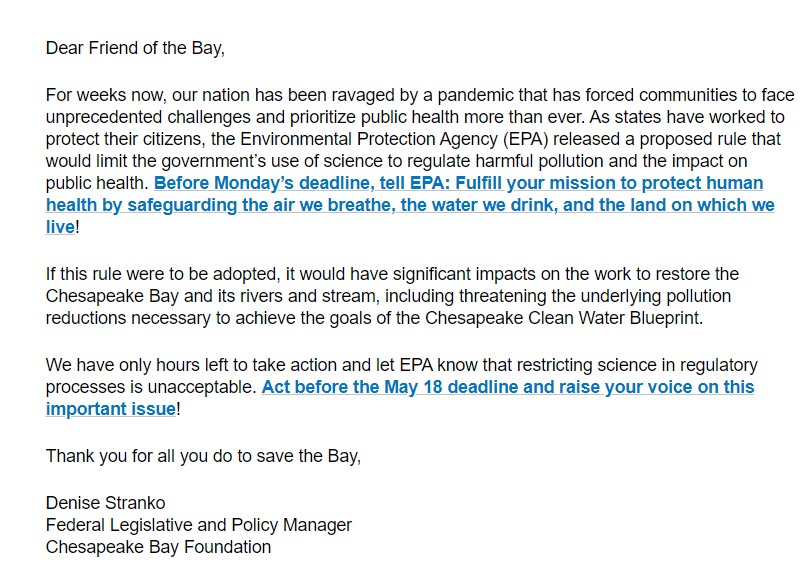You’ve probably seen this marketing trend toward simple, plain text emails sent from real people, i.e. not your nonprofit’s name. Should you try it out? What are the benefits? What are the downsides to using this email format?
Let’s get into those questions as we work through whether this email format could be a good marketing tool for your nonprofit and email audience.
What is a Plain Text Email?
Plain text emails are simply that — plain text. They don’t include banners or graphics with your nonprofit’s name and logo, branded or templated design, images or any other visual elements. A plain text email only includes text. Nothing else.
For example, check out this email from the Chesapeake Bay Foundation:

Other emails that contain images and other design elements are typically called HTML emails.
So, what are the benefits?
Sometimes, less can be more. Without the branding elements, plain text emails feel like those you might receive from a friend.
- There’s nothing to distract from the content of the email.
- They feel more personal and are more likely to be opened and read.
- And, when also sent from a real person’s name and not from your organization as a whole, these emails are less likely to get marked as spam.
If you’re looking for direct replies to the email, plain text emails are a great option. Because they feel personal, recipients are more likely to treat them as such and send a reply. Although, if it’s replies you’re after, it never hurts to mention that directly in the email content.
Sending Plain Text Emails
We’re not telling you to throw all of your well-designed email templates out the window or to never use things like images or videos in your email marketing. Those still have a time and a place, like for email newsletters, event promotions or to announce a new campaign.
Best Uses
A simple text email can be a great way to communicate a special call to action, like a donation appeal, call to take an advocacy action, or ask for feedback. They are best used when the following situations apply:
- You’d like to focus on one direct action
- You’re sharing a personal journey, story or statement
- You would like recipients to reply directly to the email
If you want to include multiple calls to action or stories, think a photo could drive home your point in an impactful way, or have a big piece of news to share about your organization (where branding could be helpful), a plain text email is likely not your best option.
Best Practices
It seems simple – just use text. But, there are a few other best practices to consider for these emails.
Use your email marketing service
Whether you use Mailchimp, Constant Contact or another email service, it’s best practice to send all of your marketing emails through that service. Even if you don’t need the formatting capabilities, avoid sending emails from your personal account.
Instead, adjust the “From Name” within the email settings to be your name and email address.
You don’t need to skip the formatting
I know I’m not the only one who formats personal emails with things like bullet points, bold and linked text. There’s no need to take plain text emails to the extreme and cut out the things that make emails easy to read and scan.
Keep it short, simple and focused
The benefits of few distractions and a personal ask are lost when you jam in too many calls to action. Instead, keep the paragraphs brief and easy to read and keep the whole email focused on driving only one action. One!
Make it personal
The email should feel like it is coming from a real person, the same person listed in the “From Name” and who signs the message. That means stripping out the marketing speak and relating to your audience and what they care about. If you can, address the recipient by their first name to take it to the next level.
To Try Them or Not to Try Them
That is the question. Should your nonprofit experiment with plain text emails? If you have an email in mind that is a direct ask and think it could be aided by a more personal touch, by all means, give it a shot. Just be sure to put measures in place so that you can look back on the results to determine whether plain text emails should be a regular part of your email marketing strategy.
In order to answer that question, compare the results from the plain text email to your overall email marketing data and data from a past email with a similar message. Or, you might even run an A/B test for a direct comparison between the two. The data you have access to might look a little differently depending on the service you use, but it would be great to look at the following metrics.
- Email opens and open rate
- Clicks and click rate
- Replies to the email
- Desired actions taken by email visitors
The last metric will likely need to be accessed through your website analytics tool, like Google Analytics.
Ready to try one out? Simple text emails feel more personal and can achieve great results in the right situation. Working them into your email marketing strategy could be a great way to grab your audience’s attention and speak to them on a personal level to get them to act.
Has your nonprofit experimented with simple or plain text emails? Are you open to experimenting? Why or why not? Let’s get the discussion going in the comments.

I *love* text-only newsletters! What I would add to the article: text-only emails are easier to share (so much easier for someone to cut and paste it into a blog or social media or their own email to share with others) and are more accessible for people using assistive tech.
It’s always great to hear from another plain text email fan in our audience, Jayne. And thank you for bringing up the accessibility benefit. That’s a really great point!
We would love to use plain text email! But it’s currently not possible with Constant Contact, so we’re kind of stuck.
Thanks for the comment, Amanda. It’s always a bummer when a service you use doesn’t have a feature you’d like to try. It looks like you may be able to get a similar plain text format through the “blank template” in Constant Contact by removing the image block and adding a text block: https://community.constantcontact.com/t5/Get-Help/Plain-text-email/td-p/330735/highlight/true.
If you don’t mind, I’d love to hear if that solution works for your organization. Best of luck!